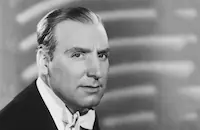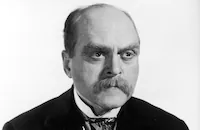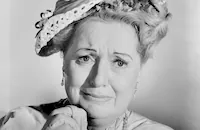Music for Madame

Brief Synopsis
Cast & Crew
John Blystone
Nino Martini
Joan Fontaine
Alan Mowbray
Billy Gilbert
Alan Hale
Film Details
Technical Specs

Synopsis
When jewel thieves Morton Harding and Rollins hear Italian immigrant Nino Maretti singing on a Hollywood-bound bus, they plot to use him as part of their scheme to rob motion picture director William Goodwin. By pretending to be talent scouts, Harding and Rollins convince Nino to perform unannounced at the wedding reception of Goodwin's daughter, where a valuable pearl necklace is on display. During Nino's stunning solo, which draws the opera-loving Detective Flugelman away from his watch, Harding and Rollins steal the necklace then, with Nino in tow, flee. After the theft is reported, District Attorney Robinson questions Jean Clemens, an aspiring operetta composer who had "crashed" the Goodwin wedding to meet famous conductor Leon Rodowsky. At the same time, Nino, who has been warned to keep quiet by the crooks, shows up at the police station, but is scared off when he realizes that he is the police's only suspect. As he leaves the station, Nino meets Jean and tells her that he is a music promoter whose most valuable possession has been stolen. After enjoying a romantic evening with Nino, Jean finds him a job as an extra for a movie musical that is being directed by Rodowsky. Because Rodowsky has been called on repeatedly by Robinson to identify the mystery tenor's voice, Nino, fearing for his life, remains mute. Later, however, Jean hears Nino singing one of her songs and, hurt by his apparent deception, angrily rejects him. As an apology, Nino turns himself in to collect Goodwin's $25,000 reward, which he tells Jean's roommate Nora to use to finance Jean's operetta. Before he claims the reward, Flugelman shows up with Spaghetti Nadzio, a cabaret tenor whom the detective is sure is Nino. To prove Nadzio's identity, Flugelman and Robinson arrange a radio broadcast in which the two tenors are to sing the same aria. When Rodowsky hears Nino singing, he immediately recognizes his voice but, in order to protect his brilliant "discovery," tells the police that Nino is innocent. Rodowsky then offers Nino a chance to sing at the Hollywood Bowl. Just before the performance, however, the jewel thieves send two of their henchmen to "silence" Nino, but the thugs mistake Nadzio for Nino and are later apprehended by Flugelman. Cleared of all suspicion, Nino tops off his sensational debut by singing one of Jean's compositions, which makes him a hit with both the audience and Jean.

Director
John Blystone
Cast
Nino Martini

Joan Fontaine

Alan Mowbray

Billy Gilbert

Alan Hale

Grant Mitchell

Erik Rhodes

Lee Patrick
Romo Vincent

Frank Conroy

Bradley Page
George Shelley

Jack Carson

Ward Bond

Barbara Pepper
Edward H. Robins
Alan Bruce
Ada Leonard
Grace Hayle

Milburn Stone
Jack Mulhall
Myra Mckinney
Crew
Joseph H. August
Samuel J. Briskin
Edward Cherkose
George D. Ellis
Perry Ferguson
Rudolf Friml
Robert Harari
Robert Harari
F. Hugh Herbert
Gus Kahn
Hans Kraly
Jesse L. Lasky
Ruggiero Leoncavallo
Herbert Magidson
Desmond Marquette
Van Nest Polglase
Gertrude Purcell
Nathaniel Shilkret
Nathaniel Shilkret
Darrell Silvera
Lynn Starling
Edward Stevenson
Vernon L. Walker
Allie Wrubel

Film Details
Technical Specs

Articles
Music for Madame
In Music for Madame, the 19-year old Fontaine plays Jean, an aspiring operetta composer in Hollywood. She meets an Italian immigrant singer, Nino, played by Italian operatic tenor Nino Martini, who is an innocent pawn in a robbery by a pair of jewel thieves. Nino conceals his identity-and his singing voice-because he's afraid he'll be blamed for the robbery. All ends happily with Nino singing one of Jean's compositions at the Hollywood Bowl. The shenanigans are enlivened considerably by some of the era's most familiar and funniest character actors, including Billy Gilbert, Alan Hale as a detective, Alan Mowbray as a famous conductor (several critics noted that Mowbray was spoofing famed Philadelphia Orchestra conductor Leopold Stokowski), Erik Rhodes as a rival tenor, and Lee Patrick as Fontaine's roommate. There's also a hitchhiking scene that's a blatant, but charming, rip-off of It Happened One Night (1934), complete with a singing truck driver.
Fontaine is second-billed to Martini, who is really the star of the film. For Fontaine, it was another colorless "the girl" role, as was her next one, A Damsel in Distress, the difference being that in the latter she played opposite top RKO star Fred Astaire, and had a top director, George Stevens, and songs by George and Ira Gershwin. RKO did not renew her contract when it expired in 1939, but she finally became a major star when she played the second Mrs. DeWinter in Alfred Hitchcock's Rebecca in 1940.
Martini had been discovered by producer and Paramount Pictures co-founder Jesse L. Lasky, who brought him to the U.S. to appear in musicals at the dawn of the sound era. Martini appeared in the revue picture Paramount on Parade and a few musical shorts in 1930, but when Lasky offered no appropriate roles, he devoted himself to an operatic and radio career. By the mid-1930s, there was a flurry of films starring opera stars, beginning with the success of Metropolitan Opera diva Grace Moore in One Night of Love (1934), which was hugely popular and earned Oscar® nominations for Moore and for the film as Best Picture. French coloratura Lily Pons also made a few films, and the films of both featured the sopranos singing pop songs. With their success, and that of Jeanette MacDonald and Nelson Eddy, Lasky was ready to try again to make Martini a movie star. In a 1980 article about opera on film entitled "Golden Voices, Silver Screen," David L. Parker wrote, "Five years earlier, at the end of the opera film's first musical cycle, Lasky...had not renewed Martini's contract. Now he built three starring vehicles around him."
About Music for Madame, Parker writes that "Martini sang Rudolf Friml songs to Joan Fontaine, who portrayed an aspiring opera composer by walking around at parties holding a huge score sticking out in front of her...Martini told interviewers that, for the movies, 'I sing exactly as I do onstage or in my studio.' That, some reviewers felt, was precisely the problem: movies required something other than a regulation-opera-tenor approach. 'Martini is little more than a voice,' opined critic Otis Ferguson." Martini's thick Italian accent didn't help, and after Music for Madame he focused on opera and concerts. He made just one more film, the British-produced One Night with You (1948).
by Margarita Landazuri

Music for Madame
Quotes
Trivia
The film lost $375,000 at the box office.
Frank M. Thomas, Lionel Pape and Ben Hendricks Jr. are supposed to be in this film, but are not seen.
Alan Mowbray's character and performance was a take-off on famed conductor Leopold Stokowski
Notes
RKO borrowed Romo Vincent from Paramount for this production, which was the first that Jesse Lasky made for the studio. According to Hollywood Reporter production charts, Frank M. Thomas and Fred Santley were cast members. Hollywood Reporter news items state that Timothy Ward, an "oldtime monologist," and Lionel Pape were also cast. The participation of these actors in the final film has not been confirmed. Several reviewers made note of Alan Mowbray's obvious caricature of well-known orchestra conductor Leopold Stokowski in the picture. According to a Hollywood Reporter news item, newsreel company March of Time selected this film as "most representative of the current pictures in production for use in a sequence titled 'Hollywood Influences the World.'" Modern sources state that the film lost $375,000 at the box office. According to modern sources, the cast included the following additional actors: Ben Hall (Bus passenger), Larry Steers, Harold Miller and Ralph Brooks (Guests), George Meeker (Orchestra leader), Stanley Blystone and Pat O'Malley (Policemen), Robert Homans (Desk sergeant), Harry Tenbrook (Electrician), James Donlan (Suspect with cold), Russ Powell ("Asleep in the Deep" singer), Sam Hayes (KAFF announcer), Jac George (Violinist), and Ralph Lewis, Mary Carr, Ben Hendricks and William Corson. In addition, modern sources complete the onscreen character list: Grant Mitchell (District Attorney Ernest Robinson), Lee Patrick (Nora Burns) and Alan Bruce (The groom [The director]).














